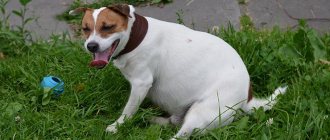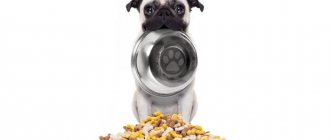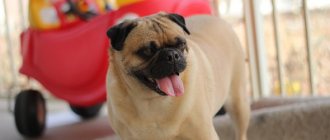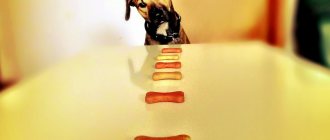Pugs are small, cute and cheerful dogs, always ready to participate with their owners in all family matters.
Like other pets, they require attention and proper care. First of all, pugs need to choose the right diet, since not only the mood, but also the health of the dog depends on it.
A well-prepared balanced diet is one of the important aspects of maintenance. Violation of the regime and improper feeding can lead to weakened immunity and the appearance of various diseases in the pet.
Puppies of this breed need to be fed more often than adult pugs. Large dogs are prone to obesity, so they need to be fed less often.
In this article we will look at what pug nutrition should be like, what options there are and which one is better.
Natural food or artificial food?
When asked what pugs eat and what to feed them, there is this point of view: a dog is a carnivore and it must be fed food that contains everything necessary specifically for a predator. The animal's digestive system is capable of digesting meat and bones - salmonella and other bacteria are quickly killed in its body.
First of all, when feeding natural products, the dog should be given chicken, rabbit, veal and lamb. It is advisable to give meat raw, as it retains more vitamins and is better digested. Vegetables are not always a source of vitamins.
Liver contains large amounts of vitamin A; this product should be given to animals with caution.
The fish is given boiled; it is rich in calcium and phosphorus.
The advantage of industrial feed is that it contains a lot of protein, little fat and calories.
So which is better? Perhaps everyone will choose the best option for their pet on their own or with the help of a specialist.
It’s quite expensive to choose a menu for a pug correctly and follow it, so ready-made food solves such issues.
Expert opinion
Tolkachev Andrey Mikhailovich
veterinarian
Nutritionists do not recommend combining dry food with homemade food. If you choose homemade food for your pet, then forget forever that the dog eats the same thing as you. Do not give any table scraps or sweets under any circumstances. Feeding your pug natural food creates the need for nutritional supplements and vitamins. Industrial food guarantees good hygiene and eliminates the risk of poisoning the dog. The main disadvantage is the synthetic additives and flavors. Plus – balanced food with the right set of carbohydrates, fats, vitamins, micro- and macroelements. Some foods use probiotics to help absorb nutrients and good intestinal microflora. Industrial feed is easy to use during trips and travels.
If the animal is predisposed to diseases of the gastrointestinal tract, add fermented milk products to the dry food twice a week.
What to feed an older pug
A dog becomes elderly when it has lived two to three times its total lifespan. A Pug can be called an "old man" when he reaches the age of six or seven years. The metabolism in his body gradually slows down and the dog no longer spends as much energy as it did before.
That is why the diet of an elderly dog should be less high in calories. It is necessary to reduce the percentage of fats and proteins, as this can negatively affect kidney function.
It is considered acceptable to replace part of the meat with lean fish or dairy products. Older Pugs may be constipated and should be given fiber to help ease bowel movements.
The daily diet of an elderly pug is calculated based on the following proportions:
- meat, fish, dairy products – 40-50%;
- crumbly porridge – 30-40%;
- vegetables, fruits, herbs – 10-20%.
If you feed your pet dry food, then you can simply buy the line “for older dogs.” Typically, these foods take into account all the needs of your aging dog.
Pros and cons of homemade food
Dogs are known to use high temperatures when preparing their food. Heat treatment of any product leads to the loss of nutrients, as well as vitamins and minerals. Therefore, the dog may experience a lack of important substances and elements.
Boiled food is an unhealthy product. It lacks vitamins and minerals, enzymes and amino acids. This product brings little benefit; the animal’s immune system is weakened, which causes various diseases. The pancreatic gland becomes overloaded and the production of digestive enzymes becomes less pronounced.
As stated above, raw meats and fresh produce must be given, as well as vitamin supplements. There is no need to give a vitamin complex at every feeding. Balance is achieved gradually, naturally - as it happens in nature.
In any case, you should always consult a specialist, especially in such an important issue as nutrition.
So, the following products are allowed:
- meat. Preferably lean meat for pugs is rabbit, chicken, turkey, lamb, veal;
- vegetables. Carrots, eggplant, garlic, cabbage, greens. They are well crushed and given with the main food;
- cereals. Buckwheat and rolled oats, with the exception of corn, rice and millet groats;
- fermented milk products, cheese, cottage cheese;
- eggs. Boiled chicken yolks and quail eggs.
List of prohibited products:
- flour and pasta products;
- semolina;
- corn;
- potato;
- sugar and confectionery;
- bread;
- smoked meats and pickles.
CAREFULLY!
All of the above foods prohibited for dogs cause gastrointestinal upset and can lead to other diseases.
Prohibited Products
It is imperative to completely exclude a number of foods that are harmful to the dog’s body from the pug’s diet:
- pasta;
- wheat and semolina porridge;
- potatoes in any form;
- legumes;
- corn and soybeans;
- chocolate and candies;
- flour products;
- sour cream and ice cream;
- smoked meats;
- mushrooms;
- any citrus fruits;
- grapes and raisins;
- pickles and marinades;
- seasonings;
- fatty meats;
- sausages, sausages and sausages;
- fried foods;
- tubular and sharp bones.
It is strictly forbidden to use any low-grade and cheap dry or wet food in your pug’s diet, which simply contains a huge amount of meat substitutes and offal, as well as all kinds of dyes and flavor enhancers.
Return to content
Advantages and disadvantages of feed
One of the main disadvantages of dry food is its artificiality and the presence of chemical additives. This is often a drawback of economy-class feed.
It’s important to choose food wisely—it’s best to consult a veterinarian in this matter. In some cases, animals fed exclusively dry food developed liver, kidney and pancreas diseases.
The advantages of industrial feeds are nutritional balance. They contain all the useful vitamins and amino acids.
IMPORTANT!
If you feed your pug dry food, be sure to provide plenty of water. It is also necessary to follow the recommended standards and measuring cups.
If you give your dog artificial food, you should not:
- combine feed from different manufacturers;
- give your dog vitamins and other supplements;
- pour boiling water over food;
- alternate food and natural food;
- Industrial food must be selected individually - some pets may have allergies. It is advisable to choose hypoallergenic food from premium brands Hill's, Acana, Eukanuba, etc. If you decide to switch to another food, it will take a week for the gastrointestinal tract to adapt to the new food. If the puppy refuses to eat dry food, you need to add a little warm water to it.
Dry food labeled grain-free is dietary and low-calorie. It is advisable to give it to dogs with obesity.
Canned porridge with meat is a type of wet food that does not require the addition of dry food. They also contain all the ingredients necessary for the development of a pet.
If you feed your dog only wet food, your little friend will eat his food quickly without chewing - this is harmful to his gastrointestinal tract. Therefore, alternate between dry and wet food.
According to reviews, the following are the most popular among dry food:
- Eukanuba;
- Hills;
- Royal Canin;
- Akana;
- FestMate;
- Canide.
Owner reviews
“This year we became the happy owners of a beautiful pug girl. However, they were soon faced with what became a whole problem of feeding her.
We tried a lot of foods, from the simplest to the holistic ones, but at best the interest in them lasted no more than a week. I learned about the Barf system from other owners. And lo and behold! It turned out that our princess really loves to eat! Now only straight."
Olga Volkova, owner.
“But natural food didn’t suit us; we’re allergic to everything. Only specialized dry food is suitable.”
Natalya Zubova, owner.
“We bought a male pug and started attending exhibitions from the age of 4 months. Experts noted dull fur and excess weight. It was not possible to achieve the desired effect with the finished food. Therefore, after consulting with the breeder, it was decided to switch to natural nutrition.
Mike was enthusiastic about the new menu, and the results were not long in coming! Literally a month later, the fur began to shine, excess weight disappeared, and at the same time, movements in the ring improved.”
Oleg Yushkov, owner and handler.
What vitamins are needed?
Vitamins that a pug needs for good health:
- vitamin A . Necessary for the good development of pug puppies, including the period of mating, pregnancy, and lactation. It is found in tomatoes, greens, carrots, liver, milk, fish oil and egg yolk;
- vitamin B. To keep your pug's skin and muscles healthy and strong, this vitamin is needed. It is found in liver, brewer's yeast, dairy products and greens;
- vitamin C . Prevents diseases of the gums and joints, improves the body's immune system. It is found in fruits and vegetables;
- vitamin D. Necessary for a growing dog - it prevents rickets, strengthens bones;
- vitamin E. It is a reproduction vitamin and is needed by pugs during periods of mating and pregnancy. Contained in beets, carrots, greens and cereals.
Interesting video
A story from a dog owner about what she feeds her pet.
Popular brands
It is impossible to say in advance what specific food your four-legged friend will like. Dogs, like people, have different tastes and reactions to food. For pugs with their characteristics, the following foods are recommended:
| Brand | Country of origin | Class | Compound | Note |
| Eukanuba ( Eukanuba ) | USA | premium | 30% natural meat, grains, fiber, eggs, fish oil, mineral supplements | |
| Hill's ( Hills ) | USA, European countries | premium | meat and meat flour, cereals, potatoes, beets, vitamin supplements | For Pugs [Symbol] Hills Science Plan Puppy Small & Miniature |
| Acana ( Akana ) | Canada | holistic | 60% natural meat, rich mineral complex, oats, potato, fruits, vegetables and berries, medicinal herbs. | There are no by-products or flavorings. Holistic and therapeutic diets. |
| FirstMate ( Fest Mate ) _ | Australia, Colombia, Canada | superpremium | Three types of meat, potatoes, vegetables, fruits, minerals and vitamins, amino acids. | The meat included in the feed belongs to the Human Grade category |
| Canidae ( Kanide ) | USA | holistic | meat and meat flour, offal, potatoes, vegetables, fruits, minerals and vitamins. |
Holistics
Holistics contain high quality ingredients. For example, meat of the Human Grade category, i.e. suitable for human consumption and subjected to minimal processing.
The food is supplemented with amino acids, prebiotics, seaweed extracts, and herbs. The price is the only drawback of these feeds.
However, the holistic composition eliminates unwanted reactions to dry food. This is the ideal food for pugs.
content in holistic products reaches 80% . Vegetables, fruits and berries serve as a source of essential vitamins, minerals and trace elements.
There are many brands that produce holistic products, here are some:
- Now Fresh or Now Natural holistic.
- Go! Natural Nolistic.
- Applaws.
- Golden Eagle.
- Orijen.
- Grandorf.
- Velcand.
- Savarra.
- Pronature Nolistic.
- Taste of the Wild.
Feeding the puppy
What food should you accustom your pug puppy to? Nothing can replace natural mother's milk. It is advisable to accustom your pet to natural food. Select proteins, fats and carbohydrates in the right proportions and add vitamins. If you do not have this opportunity, buy premium food, strictly following the dosage.
In situations where the bitch is not able to feed the puppy, the owner takes care of feeding the puppies. Powdered milk is sold to feed puppies; if this is not available, it is replaced with baby formula.
NOTE!
Cow and goat milk are contraindicated for puppies, as they can cause an allergic reaction and digestive upset.
In the first month, puppies are given:
- curdled milk;
- yogurt without sugar;
- cottage cheese;
- some minced meat;
- vegetable puree.
To ensure your baby eats well, you can add a little honey to the cottage cheese.
At 1.5 months, add quite a bit of fresh raw liver, preferably chicken, to the above.
At 2 months, it is necessary to add white fish (cod or pollock) minced and boiled to the food.
At 3 months, the puppy's teeth begin to change, so you can start giving him cartilage or soft bones.
At 4 months, the diet contains all the foods that can be fed to an adult pug.
After the fourth week after birth, puppies need to be fed 4 times a day.
Menu for dogs from 1 to 3 months:
- 1st meal - porridge, vegetable puree, some fruit.
- 2nd and 3rd meals - the menu contains meat, necks, legs and wings of poultry, which are beaten with a hammer.
From 3 to 7 months, puppies are fed the same, but the portions are slightly increased, because babies grow quickly and move a lot.
At 6 and 7 months, pugs switch to three meals a day. After 7 months, puppies are transferred to two meals a day.
There should be a bowl of fresh water in the place where the pug feeds.
Breed lines, rating
Interesting!
The nutrient requirements of dogs of different breeds
differ in composition and quantity . This is determined by size, characteristics , energy needs , structure of the muzzle, and shape of the jaws.
To decide on the type of food for your pug, focus on the following parameters:
- Health status
. If your pet is healthy, use the diet for daily feeding. The veterinarian will give advice on feeding a dog that is sick or has physiological problems. - Age.
Almost all brands produce food for puppies, teenagers, adults and older dogs. This information is on the packaging. - Lifestyle.
Pugs lead an active lifestyle in the first year, then they like to lie down and sleep. But everything is individual. Choose breed food that matches your pet’s temperament: Activ or Normal. Light (light) is suitable for overweight animals.
The Royal Canin company has developed a series of dry food for pugs, which takes into account the structural features of the dog’s head and jaws: trefoil-shaped pieces are easy to grasp with a flat muzzle. Specialized food has been developed for adult dogs and puppies: Royal Canin-Pug Adult, Royal Canin-Pug Junior.
Nutrition for an adult dog
Not all foods are good for pugs, some can be harmful. Therefore, you need to adhere to the following diet.
Proportionally, 30-70% of the diet is meat:
- mutton;
- rabbit meat;
- veal;
- bird.
25-30% of an adult dog’s menu is cereals, 20% fermented milk products. 15-20% - vegetables.
Serving 20 g per kilogram of weight.
You can give your pug cabbage, carrots, pumpkin, cucumbers, bell peppers, herbs and garlic (you can give a clove 2 times a week). The fish is served boiled, after removing the bones.
IMPORTANT!
After a year, you need to feed the dog 2 times a day. The older the animal, the less it should be fed, bringing food intake to once a day to avoid pet obesity.
Basic principles
The pug's digestive system is very delicate and sensitive. Although small dogs are capable of eating anything, you should not indulge their whims. You cannot feed your pet all foods in a row. This approach will lead to the development of serious illnesses, obesity and even the death of your four-legged friend.
One of the principles of proper nutrition is regimen. Feeding at strictly prescribed times and portion sizes adjusted according to age will help avoid health problems.
A bowl, even with half-eaten food, must be removed immediately after eating. If the dog begs for more, you will have to control yourself and not give in to your pet’s whims. A double portion will only do harm.
To avoid harming the pug's delicate digestive system, it is fed warm, solid food. Food that is too liquid can cause stomach upset. Dog owners need to ensure that there is always a bowl of clean (not tap) water and milk where the dog is fed.
How to avoid obesity?
Obesity is a serious disease of pugs, which is diagnosed very often in this breed of dog.
The owner's excessive care to ensure that his pet is always well-fed is usually to blame. Such a misconception can lead to negative consequences and contributes to the development of various diseases, such as diabetes mellitus and cardiovascular pathologies.
NOTE!
Compliance with the diet is the key to good health and long life of the pug. That is why, if you notice that your pet has become more obese, you need to contact a veterinarian, who will give recommendations on the dog’s diet for obesity and create a diet.
But before starting treatment, you need to understand what reasons led to excess weight.
Some of the most common reasons:
- overfeeding _ Overdose of food or fatty, high-calorie foods;
- lack of physical activity . If the pet is taken out for a walk for too short a time;
- metabolic disease . A slow metabolism will contribute to extra pounds;
- stress _ Moving, adding another pet to the house, changing owners - all this can lead to nervous stress. It often happens that dogs, just like people, “eat stress,” which affects their weight;
- genetic predisposition . If your pug had obese ancestors in his pedigree, then he is very likely to be obese too;
- hormonal disorder . Hormones that slow down dissimilation processes contribute to weight gain;
- worms . Toxic substances secreted by helminths provoke a slow metabolism.
Dog obesity cannot be ignored. There are many health problems - the heart has to work harder. Cholesterol levels are elevated, which leads to blockage of blood vessels and the formation of plaques, impairing blood flow. High blood pressure in obese dogs is fraught with serious complications and is dangerous for the blood vessels of the brain.
A large load falls on the musculoskeletal system. Excess weight causes joints to become deformed. Subsequently, diseases develop - arthrosis, osteochondrosis, etc.
Also, a large load falls on the liver, causing it to become fat. High concentrations of bilirubin cause jaundice, which can affect the dog's brain.
Obesity in a dog leads to problems with the dog's heat exchange, a weakened immune system, loss of sexual function and metabolic disorders, which causes the dog to get even fatter.
Medical statistics are disappointing - overweight pets live 1.5 years less than pets of normal weight.
Problems also arise for the owner, since he will have to spend additional money on special food, dietary food and treatment for the dog. We must try to avoid these problems.
The question arises, what to do and how to help a pug lose weight? You should immediately visit a veterinarian, who will make adjustments to the diet and possibly prescribe medication.
What to do if you don’t eat for the second day?
It often happens that a pug skillfully manipulates its owners, not touching the food and waiting for a more tasty morsel.
If the dog does not eat for 2 days, but drinks water, is active, goes to the toilet well, does not have a fever or pale mucous membranes, there is no need to worry. Fasting days will only benefit your pet.
But if any of the symptoms described above appear in your anamnesis, you must urgently contact a veterinary clinic to establish an accurate diagnosis.
The best of the inexpensive ones
When choosing inexpensive food, you need to look at the composition and recommendations of the manufacturer. Some of them recommend mixing canned food with cereals, which means that canned food is not a complete diet. You should also avoid those that do not detail the ingredients used.
One of the most inexpensive foods is Organics food .
There are different flavor and age ranges, the composition is described in detail, the grain content is no more than 2%. At the same time, the food is quite high in calories; a pug weighing 8 kg requires only 200 grams of food per day.
Another economical option is Frank's ProGold food .
At approximately the same price as Organix, the composition contains very general data. There is much less meat and its components (only 80% versus 98%). In this case, the daily norm is 800 grams for a pug weighing 8 kg.
Food Nero Gold.
The price level is the same as the previous two. The composition is even less detailed than Franks's. Calorie content and percentage of ingredients are not indicated. The daily norm is also 800 grams per 8 kg pug.











